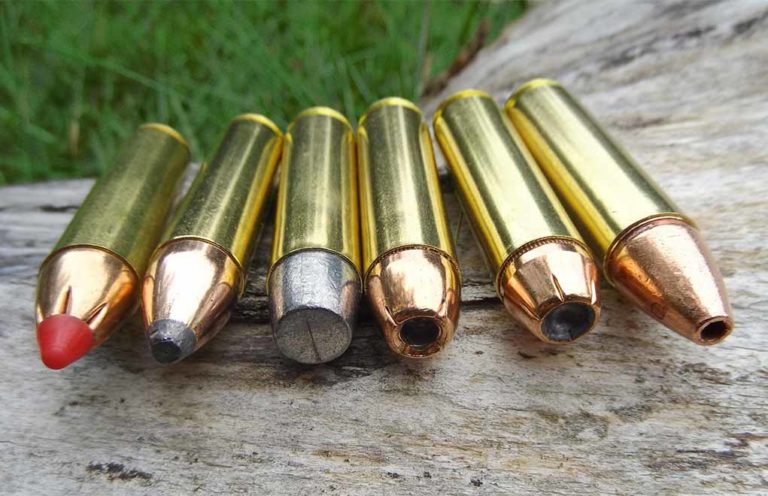
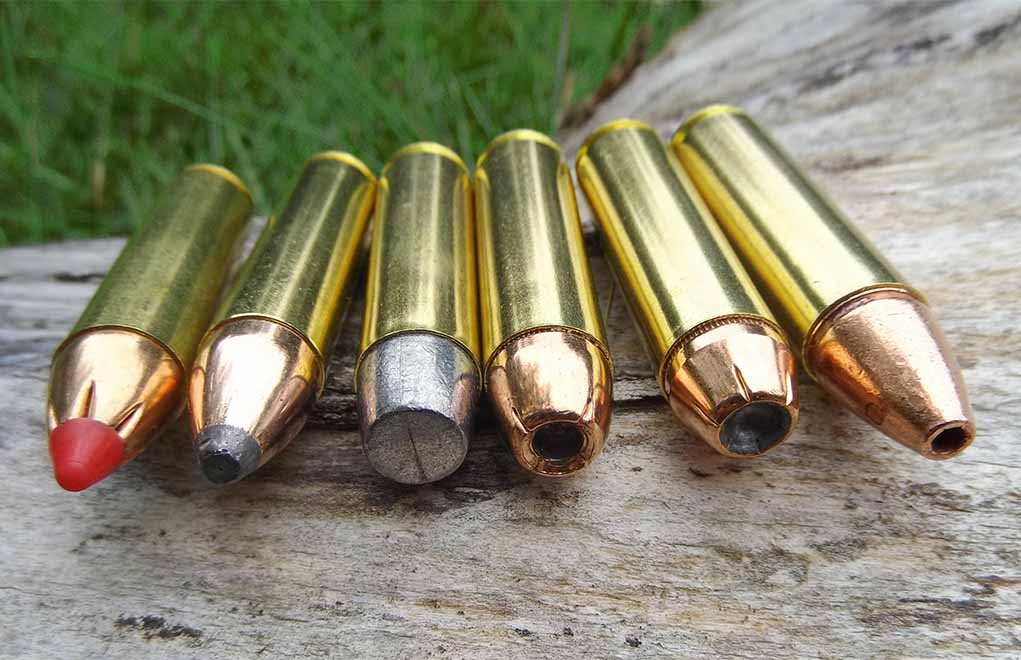
Even with modern advancements, straight-walled cartridge ballistics remain very consistent, which keeps them a short-range affair.
What Are The Characteristics Of Straight-Walled Cartridges:
- While they can be pushed further, they are essentially short- to short-medium-range options.
- Their velocity tends to dissipate quickly.
- At their optimal ranges, they can deliver a load of energy on target.
Today’s hunter has a plethora of cartridges to choose from. Certain states and regions have limitations on what caliber and type of gun can be used. As a result, there’s innovation in lots of areas that would otherwise have been left behind by the march of technology.
Straight-walled cases offer a tremendous amount of utility in a surprising number of firearm types. They were among the first successful self-contained munitions developed. It was the advent of the self-contained metallic case that allowed for the first repeating arms to be manufactured and distributed on an industrial scale. Many of these cartridges are still in widespread use today—despite being more than 100 years old.
Why Straight-Walled Cases?
In recent years, a number of regions began allowing the use of straight-walled cases, mainly as an alternative to the use of shotguns. Shotguns have tremendous recoil and are not especially accurate, even with top-shelf slugs designed for rifled barrels. Recoil-sensitive hunters were essentially deterred from hunting as a result.
Because rifled shotguns are basically rifles, the idea came about that straight-walled cases would be an ideal substitute; most are, when compared to bottle-necked cases, low-pressure and have limited range. Many of today’s straight-walled cases have the same general effective range as that of a rifled shotgun—around 150 to 200 yards at a maximum (but more on that in a moment).
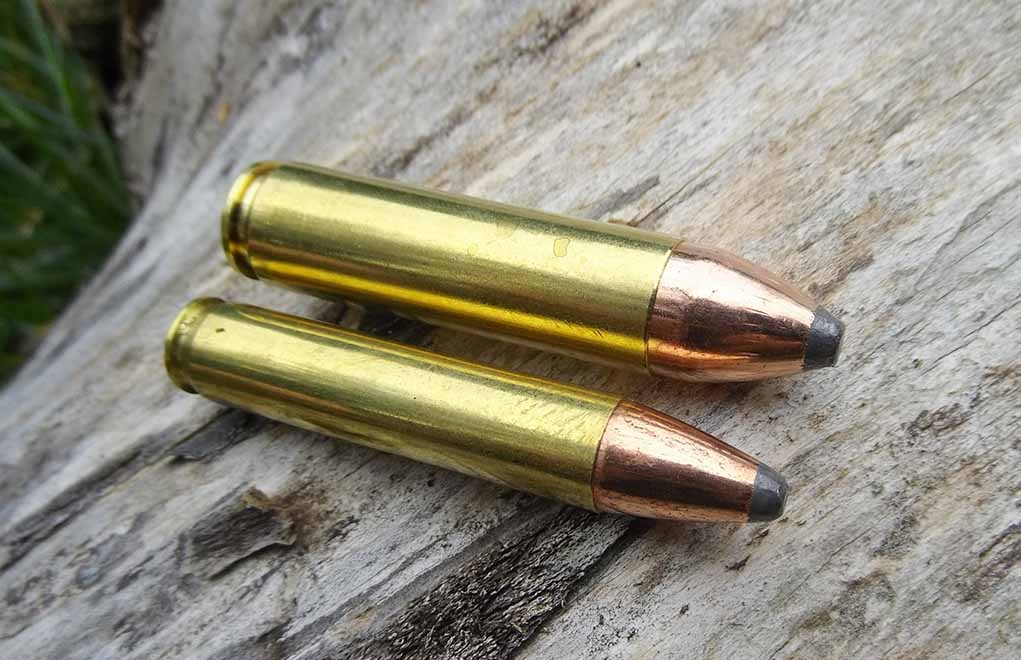
The legal requirements surrounding straight-walled cases often dictate what type of rifle can be used. Some areas (such as Michigan) have physical restraints on the size of the case itself. A cartridge case—and note that the bullet is not included here—must be between 1.16 and 1.8 inches and .35-caliber or larger. This means that rounds from .357 Magnum to .500 Smith & Wesson can be used.
Straight-Walled Characters and Characteristics
The most common and popular straight-walled hunting cartridges are the .357 Magnum, .45 Colt, .44 Magnum, .450 Bushmaster and the newly released .350 Legend. There are other rounds that fill the requirements, but there are no significant ammunition makers or common, reliable rifles made to fire them. As an example, the .500 and .460 Smith & Wesson are great rounds, but there are really no common or affordable rifles made to make use of them. S&W makes great revolvers, but not every hunter wants the challenge of handgun hunting or possesses the fortitude of wrist to master such hand cannons.
The traditional lineup comprises .357 Magnum, .45 Colt, .44 Magnum and .45-70. I consider these cartridges “traditional” straight-walled cases. The first three are geared toward revolvers, but there are great hunting rifles made to take advantage of their qualities. The .45-70 is generally considered a rifle cartridge, but today, you can find handguns that chamber it.
.357 Magnum
The .357 Magnum is the smallest straight-walled case in common use for hunting. There aren’t many semi-automatic options out there, but there are wonderful lever-action rifles and bolt guns made to fire it. The .357, while powerful in a concealed-carry revolver, is limited to about 50 to 75 yards in a hunting scenario, so large deer should be avoided.

The .357 Mag. is best in a compact, 16- to 18-inch lever-action with either a red-dot sight or open irons. Most ammunition offerings are loaded to handgun power, which means that many don’t generate a tremendous amount of speed. Buffalo Bore loads several very powerful options, including a 158-grain JHP that can achieve more than 2,000 fps from a rifle-length barrel.
.45 Colt
The classic .45 Colt was once the choice of the U.S. Calvary in General Custer’s era. It was made famous early on and today enjoys a healthy following and a wide range of ammo and gun choices. Today’s .45 Colt ranges from old-school, 255-grain cast lead to advanced, 230-grain Sig Sauer V-Crown self-defense loads.
For hunting, I like to go big and somewhat slow. The .45 Colt can sling some serious lead—but with low recoil and fairly low noise, because most heavy ammo never gets supersonic. Just like the .357 Mag., the .45 Colt is best in a lever gun with a red-dot or open irons. Effective range from a lever-action rifle is about 75 to 100 yards on medium to large deer. The ideal range is 50 yards.
Go Big With These Ammo Articles:
- Does The .357 Magnum Rifle Reign Supreme?
- .500 Linebaugh: Taking Revolver Cartridges To The Next Level
- Big-Bore Lever-Actions: Steel Henry .45-70 Is Golden
- Gun Review: Magnum Research BFR
.444 Marlin - Ruger 77/44: A Masterful .44 Magnum Rifle
The best part of the .45 Colt is that it is a low-pressure cartridge that allows for easy practice while having high bullet mass. The fact that most factory ammo is slower than 1,000 fps means that it will run out of gas very quickly. It has good penetration qualities with hard-cast lead bullets. If you want that nostalgic hunt with a classy lever-action and red flannel, this is your cartridge.
.44 Magnum
The .44 Magnum is what most people consider to be the best of the “old-school” straight-walled cases. Developed by Elmer Keith from the .44 Special, the .44 Magnum boasts .45 Colt bullet mass at .357 Mag. speeds. I tested a Ruger 77/44 bolt-action rifle at one point and found it to be among the best and fastest-handling straight-walled rifles available today. Hornady 225-grain FTX loads clock at about 1,800 fps in that rifle, meaning that the effective range is bumped past the .45 Colt and .357 Mag. to around 150 yards.
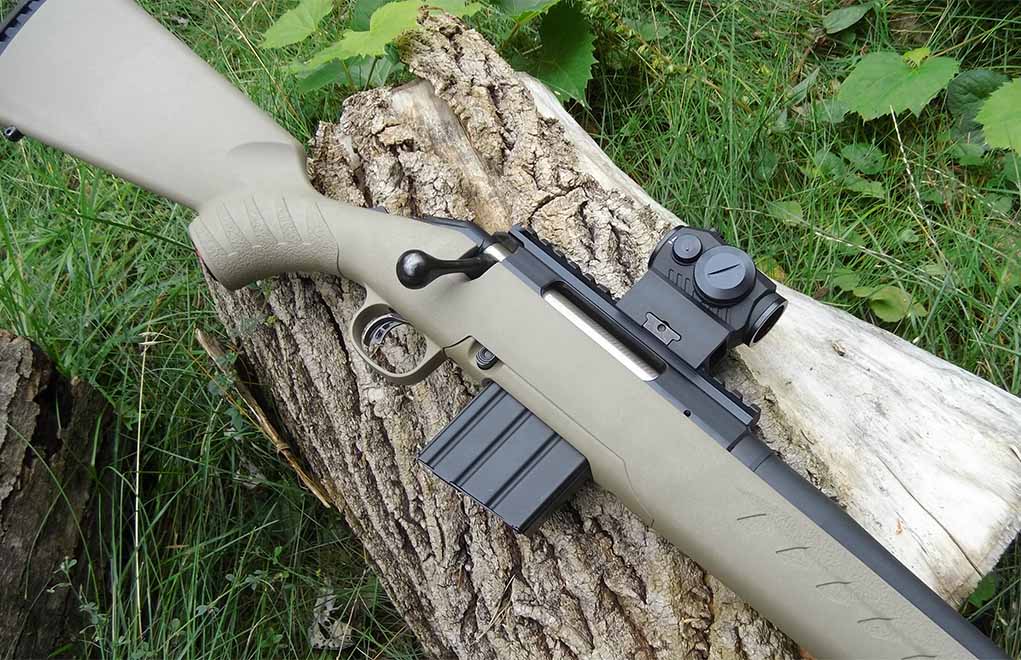
The .44 Mag is available in lever-actions and bolt-actions, but there’ve been some great semi-auto rifles made in years past. The .44 Mag. is best used with scopes in the 4x range, although irons and red-dot sights are also great.
Most hunters who use a “traditional” straight-walled case are going to be using .44 Magnum. The .45 Colt and .357 are fun and easy to use in a rifle, but the .44 Mag. is just as easy-handling, faster and more powerful in every way.
.45-70 Government
The old .45-70 is just as popular today as it was when it was first introduced in 1873. There are numerous rifles that chamber it—from single-shot Sharps replicas to brand-new, all-weather Marlin lever-actions.
The .45-70 boasts a wide range of bullet options, sometimes in excess of 500 grains. The massive amount of lead the .45-70 can deliver in a somewhat small package makes it a tremendous performer against all game on Earth.
It should be noted that the .45-70, while only slightly more powerful than .450 Bushmaster, isn’t legal in all areas that allow straight-walled cases because, at 2.105 inches, it is longer than the stipulated 1.8 inches.
The Modern Straight-Walled Cartridge
The interesting part of the modern straight-walled case is that it’s something of an evolutionary throwback in the “tree” of cartridge development. While the .450 Bushmaster and .350 Legend are new cartridges relative to the .45 Colt and .45-70, they share a number of the same features and performance.
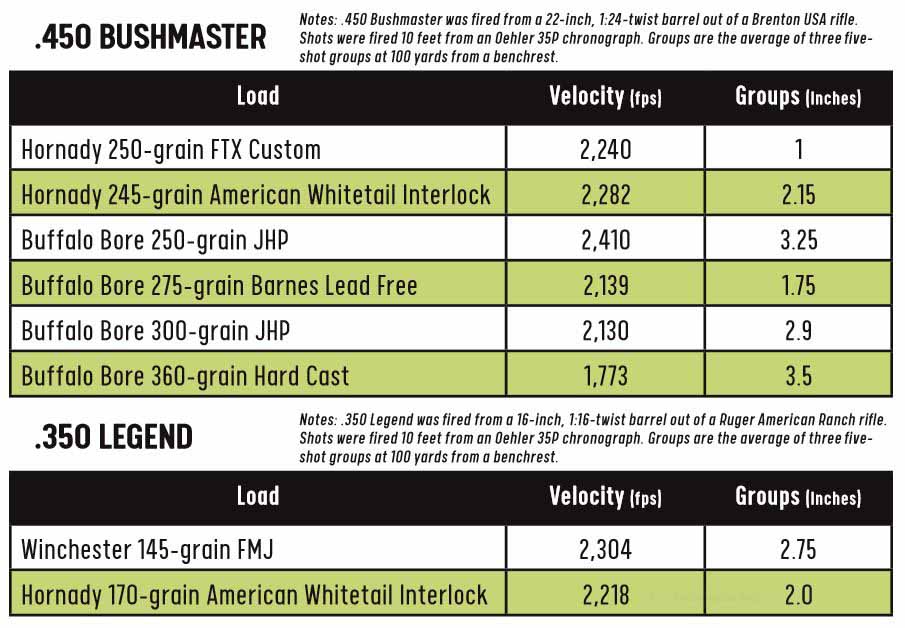
The .450 Bushmaster is the preeminent straight-walled hunting cartridge available today. As a generalization, it typically offers a 250-grain bullet at 2,200 fps. This means it has an effective range of 200 yards and no real upper limit on the size of North American game it can be used for. Bullet type for the .450 Bushmaster is geared for deer, but there are other offerings that can be used for larger, heavier animals that are tested in this article, such as the Buffalo Bore 360-grain Hardcast Flatpoint.
As far as performance and rifles are concerned, the .450 is something of a hybrid. The cartridge was originally developed for the AR-15, but because it shares the same case head size as the common .308 Winchester, it was readily adapted to bolt-action rifles. If you’re a handloader, you can make very, very powerful loads in your bolt-action that are otherwise unsafe in the fragile AR action.
Many AR rifles today struggle with reliability when it comes to the .450 due to subpar magazines and unsuitable gas system and buffer setups. I’ve fired every, single .450 AR made commercially today, along with many other custom options. I’ve found exactly one that works with perfect reliability and accuracy: the Brenton USA Ranger Carbon Hunter (featured in this article). Brenton USA also makes the most reliable .450 Bushmaster magazine on the market. Again, I tested all known options and have yet to find one that works better.
Bolt-action rifles such as the Ruger Gunsite Scout are available in .450 BM. Bolt-actions are generally more accurate than semi-autos and are more reliable, especially feeding the short, fat rounds such as the .450. One can make a case that, despite being made for the AR, the .450 is best in a bolt-action. The round is basically a large handgun cartridge and makes use of magnum pistol powders. As a result, it can offer challenges in the complex inner workings of an AR. In a .308 bolt gun with standard AICS pattern mags, all that’s required is a simple barrel change to fire .450 Bushmaster.
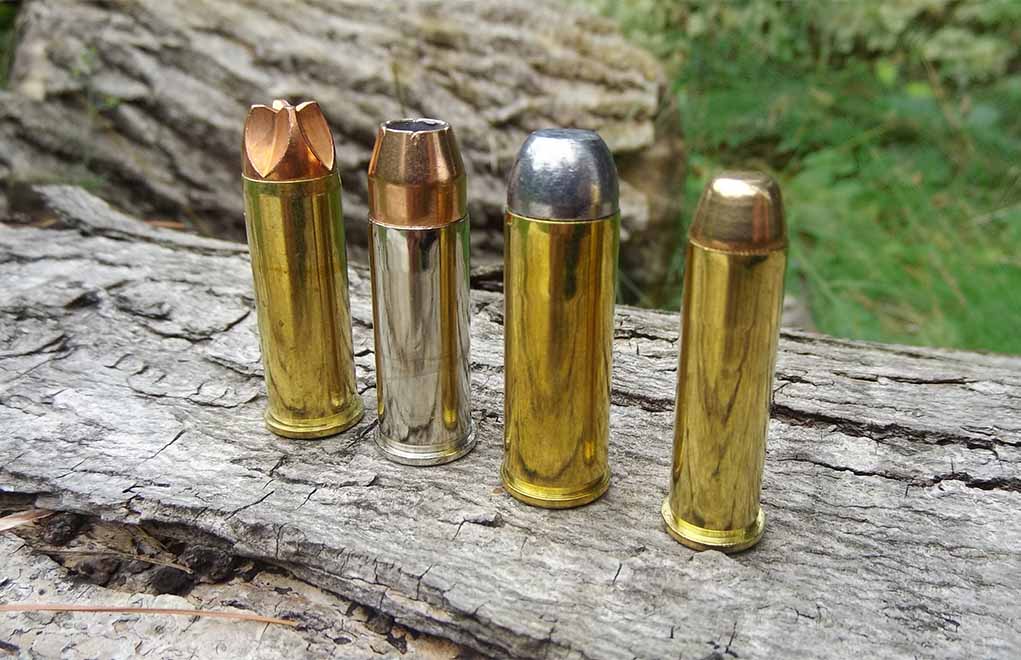
Precision Rifle Company is a rifle builder that makes the most accurate .450 Bushmaster rifles in the world—period. It was also the first company to introduce custom .350 Legend rifles. This company knows more about these two cartridges and what makes them accurate than any other riflesmith. Making straight-walled rifles that are accurate and reliable is a challenge, and Precision Rifle Company dominates the bolt-gun scene. I strongly recommend talking to the folks there about your straight-walled hunting rifle build.
The .350 Legend is the latest straight-walled cartridge to make waves on the hunting scene. This round was designed by Winchester primarily to address some perceived shortcomings associated with the .450 Bushmaster.
A prime selling point of the .350 Legend is that it boasts low recoil and low expense when compared directly to the .450 Bushmaster. Is it better? Well, the .350 has yet to have its public trial. As you’re reading this, thousands of hunters are preparing for their traditional excursions, and many will be taking the .350 Legend to the field for the first time. Time will tell how effective it is.
Should you invest and take the dive right away for a brand-new cartridge such as the .350 Legend? That depends on what you want to get out of the deal. The .450 Bushmaster is a very powerful cartridge that can generate some serious energy, but it’s too much for some shooters as a result. This was the exact problem that existed with high-recoil slug guns before straight-walled case regulations came into play.
The .350 offers about half the recoil of the .450—but at the price of bullet mass and energy. The low recoil and cost of the .350 are not enough to make it superior to the .450 Bushmaster, but it will be enough to get people to try it out. It’s been said in some hunting circles that the .350 Legend will do to .450 Bushmaster what 6.5 Creedmoor did to .308 Win., but I seriously doubt it’ll cause as widespread a stir.
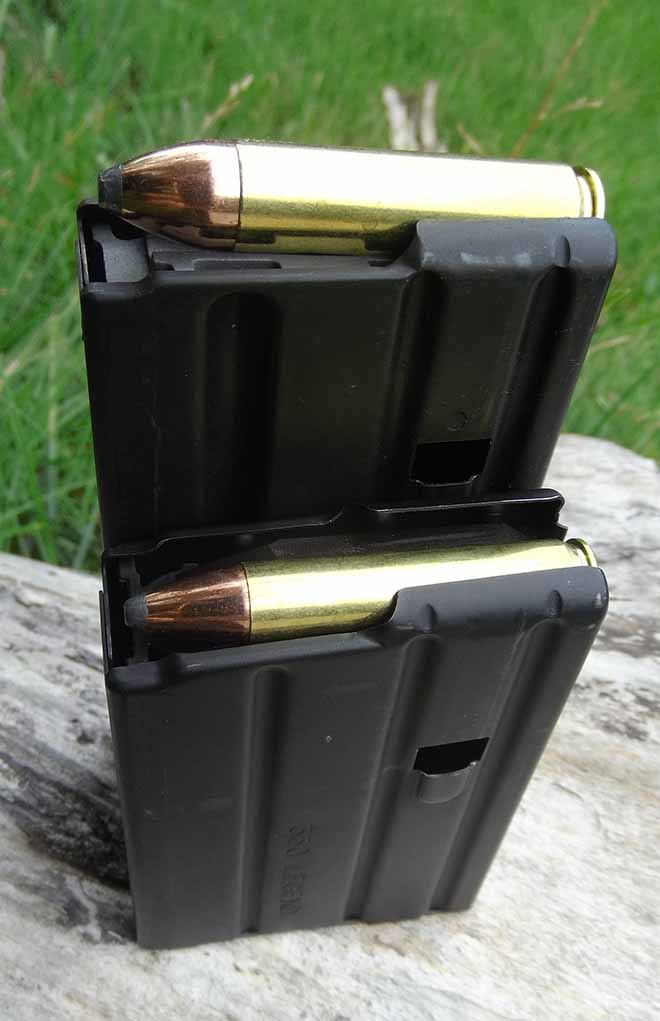
Overall, the .450 Bushmaster will continue to dominate the straight-wall game for the foreseeable future. If you’re getting into serious hunting with straight-walled rifles, the .450 BM is king. There’s no other commonly available medium-to-large-game, straight-walled round that delivers as well as the .450 at the maximum range straight-walled cases are good for.
Effectiveness OF Straight-Walled Cartridges
I’ve been hunting with the .450 Bushmaster for a number of years and was one of the first to write about the need for .450 bolt-actions well before Ruger released its Gunsite Scout and American rifles. There are many misconceptions—and outright lies—about these cartridges and rifles that need to be addressed.
First and foremost is that all the straight-walled cartridges in this article max out at somewhat close range. Yes, they can, of course, be fired farther, but the design, mass and speed of the bullets are what really determine effective range. The .357 and .45 Colt are best at bowhunting distances inside 50 yards. Any farther, and you encounter massive drops in energy and substantial bullet drop. The .44 Magnum can stretch that a bit more, with the ideal range being 50 to 100 yards—only a marginal increase over .357 and .45 Colt.
The .45-70 is commonly thought of as a long-range round. However, in today’s rifles with today’s bullets, it’s assuredly not. Again, it can, of course, reach a target at long range, but that’s not the point of hunting. The .45-70 is best at 75 to 150 yards on most game, but it drops significantly at any range past that.
Even modern straight-walled cases are not beyond this. It’s commonly seen that the .450 BM is advertised as being accurate to 300 and 400 yards, but this is entirely untrue. The trajectory is like a rock in a sock, even with good loads. The .450 is the same as the .45-70, in that it’s best at ranges inside 150 yards. There isn’t tremendous bullet drop from 150 to 200 yards, but beyond that, the round falls off rapidly.
The .350 Legend is no better. It’s essentially the same as .357 Magnum—on steroids—which means it’ll stretch out the range to about 100 or 150 yards (roughly the same as the .450 Bushmaster). The low bullet mass is the reason the ideal distance is about 100 yards.
Just to make sure the point is made: There’s a major difference between how far a bullet can travel and what a bullet does when it arrives. Long shots can be made but should not be sought out with straight-walled cartridges.
As far as accuracy is concerned, most ammo made for .357 Mag., .45 Colt and .44 Mag. is made for handguns. The tolerances and bullet quality vary widely. Expect most rifles of any action type to group at about 3 inches at 50 yards. In the case of most replica lever-actions, this is great performance. Modern bolt-actions, such as the Ruger 77 Series, will do slightly better, usually grouping at 2 inches at 50 yards.
The big boys tend to do better at longer ranges. Most .45-70 rifles can be quite accurate. A Ruger No. 1 single-shot rifle I tested would group at 1 inch at 100 yards with 405-grain soft-points, but this wasn’t the norm. Most other rifles I tested have been in the 3-inch range at 100 yards.
The modern rounds, such as the .450 Bushmaster and .350 Legend, can be had in much more accurate guns—but again, they’re not the norm. Most factory .450 BM and .350 Legend rifles will shoot about 2 to 4 inches at 100 yards. Custom rifles, such as those from Precision Rifle Company, will shoot sub-MOA all day in those calibers but are still limited by the cartridge, as far as effective range is concerned. This means that while the rifles are accurate, the bullets still run out of gas at the same ranges as factory guns.
Most AR-pattern rifles firing .450 Bushmaster will group at about 3 inches at 100 yards. This is good performance for the most part, and if your gun does better, consider yourself lucky. Brenton USA’s rifle in this article performs extremely well for a gas gun and is able to put five shots into 2 inches at 100 yards. This isn’t a usual case for either the .450 AR or most .450 ammo available today.
Terminal Effectiveness
Because there’s an obvious correlation between bore size and bullet mass, bigger bullets will always be objectively better. Due to the fact that the straight-wall game is inside 200 yards for most people, it’s akin to playing dodgeball with everything from tennis balls to exercise balls: You’re always going to be better with a bigger ball, given that the game is at a set distance.
A deer will be equally as dead if shot by a .357 Mag. or a .500 S&W, so it all depends on shot placement and the individual rifle, bullet and animal. Because we’re playing with limited options, penetration is key. In the straight-wall game, a solid bullet is sometimes better than an expanding one, in that it can make up for low mass or low speed by punching in deeply. I switched to solids in my own .450 rifles after seeing lackluster terminal performance in the field with soft, expanding bullets.
Hardcast lead is very, very hard to beat at penetration, which is the only reason that .45 Colt made it onto this list. Those big cowboy loads are slow, but a 255-grain wadcutter at 900 fps can floor a deer on penetration alone. I’ve seen soft .450 BM loads shatter in two deer after hitting only a shoulder blade.
More technology isn’t always better, and bullets aren’t where you want to start adding moving parts when that trophy buck is on the line.
The goal of the straight-wall regulations was, for the most part, to open the hunting field to more hunters of various ages and ability. The straight-walled cases allowed are thus close to the power of a modern slug gun— sometimes, a little more and other times, a little less. The across-the-board effective ranges are the same as most slug guns—that being inside 200 yards.
Despite the advances made and new cartridges being introduced, straight-walled hunting is a fairly short-range game.
The article originally appeared in the October 2019 issue of Gun Digest the Magazine.

Next Step: Get your FREE Printable Target Pack
Enhance your shooting precision with our 62 MOA Targets, perfect for rifles and handguns. Crafted in collaboration with Storm Tactical for accuracy and versatility.
Subscribe to the Gun Digest email newsletter and get your downloadable target pack sent straight to your inbox. Stay updated with the latest firearms info in the industry.

![Best Concealed Carry Guns In 2025 [Field Tested] Wilson Combat EDC X9S 1](https://gundigest.com/wp-content/uploads/Wilson-Combat-EDC-X9S-1-324x160.jpg)


![Best 9mm Carbine: Affordable PCCs [Tested] Ruger Carbine Shooting](https://gundigest.com/wp-content/uploads/Ruger-Carbine-Shooting-100x70.jpg)
![Best AR-15: Top Options Available Today [Field Tested] Harrington and Richardson PSA XM177E2 feature](https://gundigest.com/wp-content/uploads/Harrington-and-Richardson-PSA-XM177E2-feature-100x70.jpg)

.44 Magnum is effective to 150 yards?!? Where did you get that idea? Do you realise that .44 magnum handguns are considered effective for large bears in Alaska? People handgun hunt with them all tge time at 100 yards! Add 400-500 fps to the .44 Magnum by using that cartridge in a rifle with a 20″ barrel, rather than an 8″ handgun, and you have a round that’s effective on large bears out to at least 300 yards! That means it would be effective on deer out to 500 yards, at a minimum! You need to start thinking with a little more common sense.